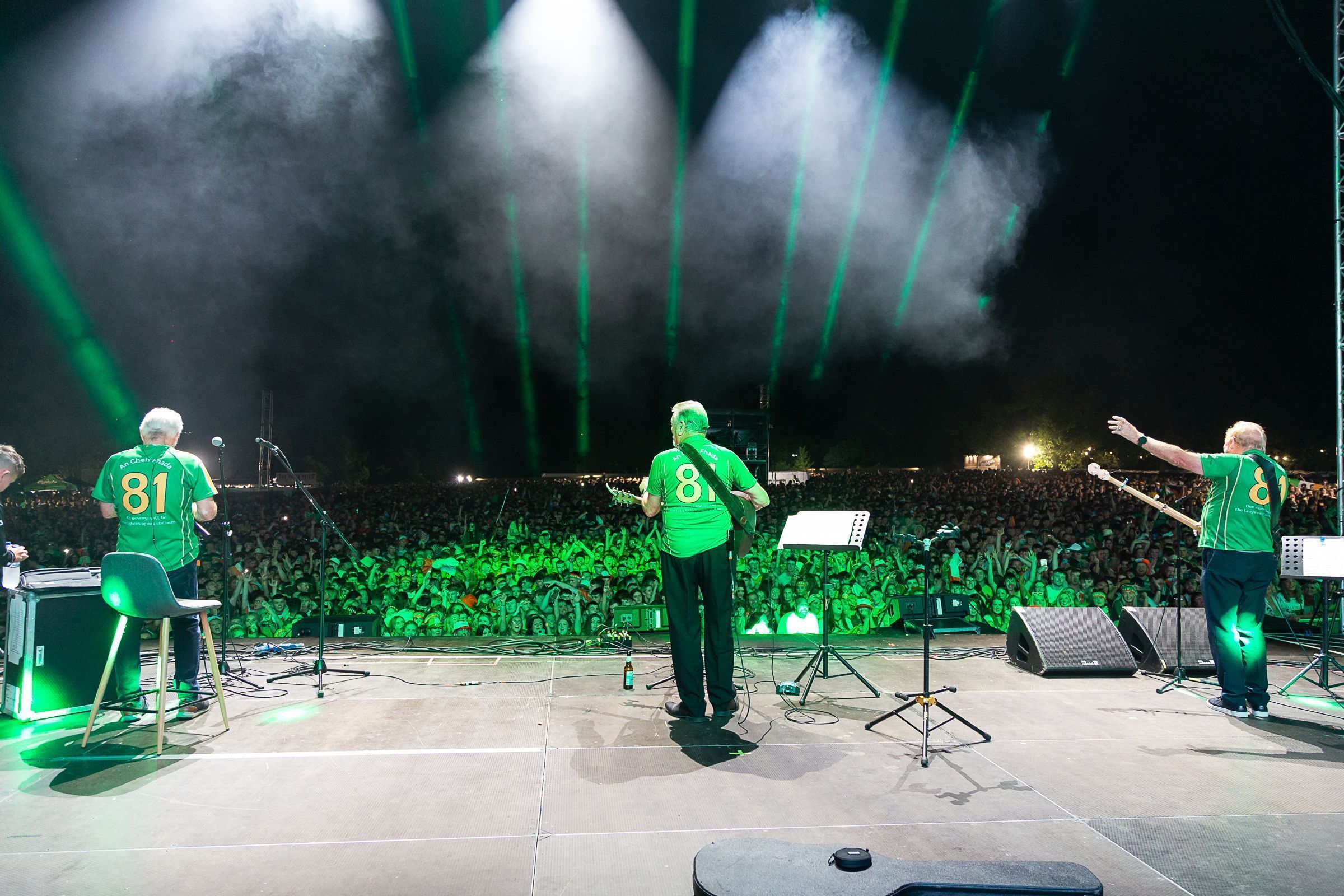BOOK REVIEW
LIKE just about everybody else I laughed like a drain at Steve Coogan’s Martin Brennan. Still do. He kills me – in a non-IRA way, of course.
The character appeared in a St Patrick’s Day 2019 episode of This Time with Alan Partridge and the conceit was that Brennan, a Sligo farmer, had been identified as a Partridge lookalike and was being brought on for a bit of One Show-style light sofa banter.
But in his bad suit and polyester-patterned-jumper-and-tie combo, Brennan eschewed banal chat and launched instead into a rendition of two rebel songs – Come Out Ye Black and Tans and The Men Behind the Wire – numbers he was undoubtedly used to banging out in whatever imaginary rural pub he spent his evenings.
For Coogan, it was an incredibly risky sketch. Brennan was a 21st-century version of the 19th -century Punch cartoons depicting the Irish as compulsively violent slope-headed simians. Rather than ape-like features, Brennan had bad teeth, ruddy cheeks, a combover and an accent thicker than a submarine door. He exposed his violent nature to us not by wielding a knife under a ragged cape, but by singing about his admiration of the IRA (The Men Behind the Wire, of course, is not an IRA song, but few watching – in England or Ireland – would have made that distinction).
Coogan stood to take a hammering. The Brennan character was clearly based on a racist tropes and even the traits which mitigated his physical repulsiveness were characteristics lazily attributed to all Irish: The glint in his eye, the gregariousness, the childlike urge to entertain.
But the gamble paid off in spades. If a whingefest about IRA propaganda on primetime TV was expected from the right-wing press, it never came. Middle-England laughed but the Irish not only found it funny, they took Brennan to their hearts. But why would a nation trained by history to be adept at spotting slights embrace a walking, talking, singing stereotype?
A number of factors were at play. Coogan is half-Irish and has not shied away from historical English-Irish tensions in his comedy and so on this side of the Irish Sea we were well-disposed towards him from the off. And a savvy selection of visual and verbal inclusions made it clear that Brennan was not a preposterous figure of fun from the land that time forgot, but an empowered herald of very modern Irish mores and attitudes.
His very name had viewers off-balance from the outset. Rather than select one of those ‘funny’ Irish names that the English can’t pronounce, Coogan opted for a brace of dull, unthreatening monikers that, while historically and vaguely Irish, were sufficiently Anglophone to make Martin Brennan’s brash and confident republicanism, when it came, a shock to the system. The name carried with it the message that a respect for Ireland’s rebel spirit is not confined to dynamitards and terrorists.
The placing of an English gent in a tuxedo on the sofa beside Brennan gave subtle but considerable heft to the Irish farmer’s unapologetic patriotism. The shorthand was unmistakable to anyone who’s ever watched a film or read a book. Tuxedo Man: Downing Street mandarin or a British army colonel in a formal dinner in the officers’ mess.
In his new book ‘Rebel Notes. Popular Music and Conflict in Ireland’, Stan Erraught cites Martin Brennan in the introduction, and ponders the reality that Coogan would have been unlikely to get away with the Brennan character 20 years ago. Indeed, he’d have been unlikely to have been allowed to make the sketch 20 years ago. Increasing distance from the Troubles is changing not only our perceptions of music and artists, but our perceptions of what they’re telling us, not only about the world around us, but about ourselves.
As iconic as the Martin Brennan sketch, but immeasurably more controversial, is a football song that has become a lightning rod for post-conflict unionist anger and confusion. The Celtic Symphony by the Wolfe Tones is ostensibly about a Glasgow sailor who returns to his home city after a life on the ocean wave and comments on the city of the team he loves as he sees it now and the Parkhead stadium. He sees “graffiti on the wall” which reads “ooh, ah, up the Ra”. The catchy refrain of those latter five words are a hook on to which the Wolfe Tones audience latches with huge enthusiasm, particularly at the band’s final-night Féile gig in the Falls Park.
CONTROVERSY: The Wolfe Tones’ Celtic Symphony provokes varied reactions 
Unionist concern about the legacy issues have coalesced around the annual singalong, to the extent that the ‘biggest show in the country’ has at times spent an entire week fielding irate phone calls from unionist callers expressing their disgust and nationalist callers telling disgusted unionists to calm down or get used to it. Erraught parses the controversy entertainingly and comprehensively, and from a southerly direction to boot.
Controversies down there over the song – being sung by the Irish women’s football team, for instance, or at an RDS rugby match – are sporadic at best and nowhere approaching the heat or intensity of the debate in Belfast. He argues that antagonism in the south to The Celtic Symphony, as well as the adoption by the rugger-buggers of Dublin 4 of Zombie by The Cranberries – may be seen as a response to the rising electoral strength of Sinn Féin. His deconstruction of Fintan O’Toole’s notoriously pompous response to the singing of such songs is particularly effective and apposite.
Zombie shares a connection with the big beast of Irish music, U2, in that Erraught deems it one of the two best known songs about the north from bands south of the border – Sunday Bloody Sunday being the other. His dual analysis of the vapidity and lazy nihilism (my words, please note) of the two songs is witheringly accurate. “Despite being separated by more than a decade, the two songs display a similar ahistoricised understanding: the conflict is endless and pointless and its protagonists doomed to repetition. The very title of the Cranberries’ song point to this: a zombie is undead, condemned to feed on the living – and to wander ‘outside time’... Bono asks, ‘how long must we sing this song?’ as if condemned to do so forever. Dolores O’Riordan [Cranberries’ singer] suggests ‘it’s the same old theme/since 1916’. The chorus of ‘Zombie’ – ‘with their bombs and their guns and their guns and their bombs’ – is meant to sum up the murderous inanity of a conflict without meaning.’”
The empty moralising of the Cranberries and U2 and the frankly tiresome bunfights over ‘Ooh, ah, up the Ra’ seem even more objectionable when we’re presented with a new musical battlefront which reflects and provokes similarly familiar reactions to the aforementioned, but which has exploded on the scene with an energy and a freshness which threatens to make the exhausted old themes of legacy and culture cool, vibrant and even sexy. While Erraught deals with the responses of Irish bands to the conflict in the north in a pacy, accessible and highly readable way, one senses a frustration, almost, at their failure to have the courage of their lack of conviction. By contrast, he seems wide-eyed with delight at having as a case study a band who weren’t forced to confront the Troubles in their work, but who were born out of it and who exist to yell their take on it to the world.
SWAGGER: Kneecap aren’t afraid to say it as they see it
The stand out chapter – Ní Cheapaím [I Don’t Believe It] – is the stand-out chapter not only because of the cheer-worthy phonetic Kneecap pun, but because of the hugely engaging and enlightening discursive nature of its Kneecap narrative. It ranges from the Welsh language to sociology to a short history of Irish rap to education to Hollywood and countless other stops in between.
If journalism is an aspect of the Troubles that deserves to be held under a bright light of analysis for its multiple failures both active and passive, then music journalism is a subgenre of the industry that defies analysis because it simply didn’t take part in the fray. Which means that there is a vast, fertile field out there waiting to be worked. Stan Erraught has been out with the combine harvester – and his harvest is a large and rich one.
Rebel Notes. Popular Music and Conflict in Ireland. By Stan Erraught. Beyond the Pale Books, £14.00.








